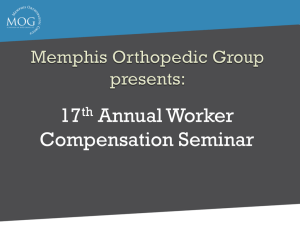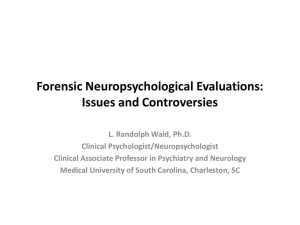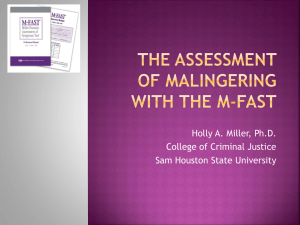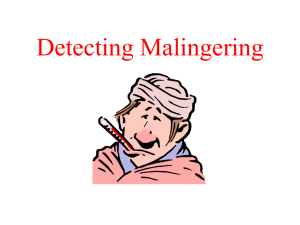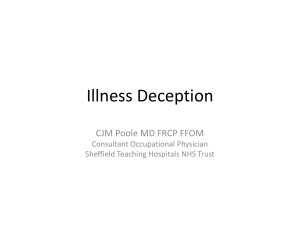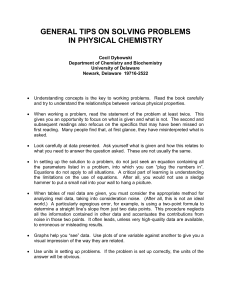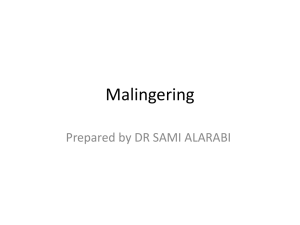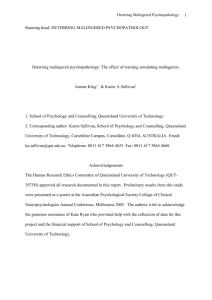Malingering - American Academy of Disability
advertisement
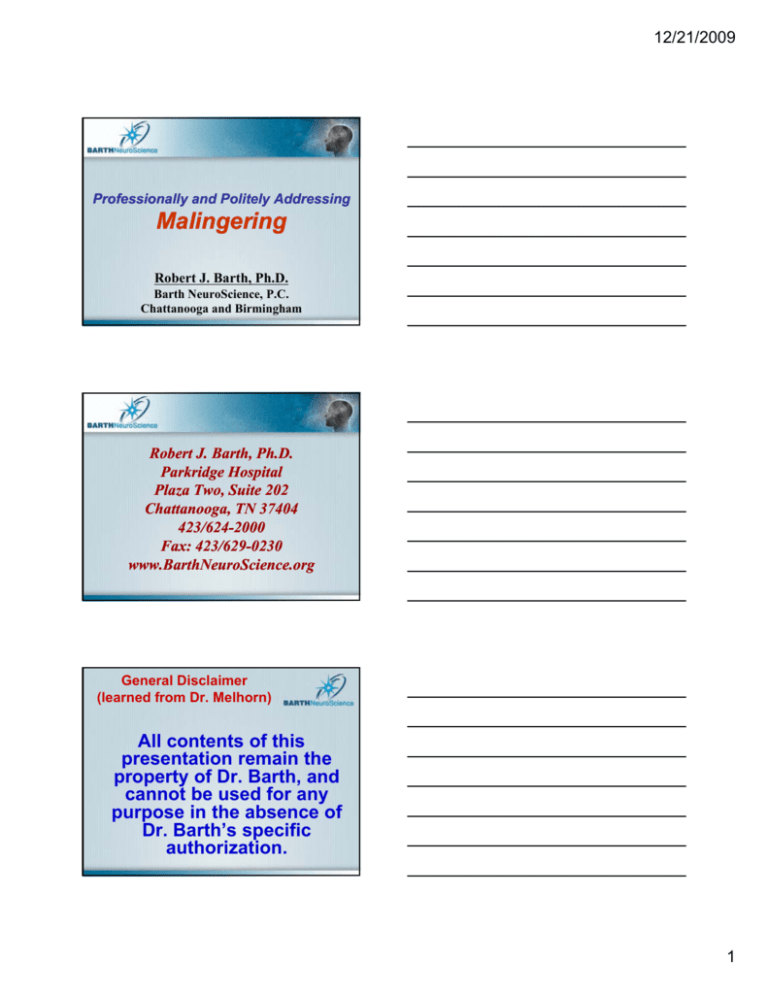
12/21/2009 Professionally and Politely Addressing Malingering Robert J. Barth, Ph.D. Barth NeuroScience, P.C. Chattanooga and Birmingham Robert J. Barth, Ph.D. Parkridge Hospital Plaza z Two,, Suite 202 Chattanooga, TN 37404 423/624--2000 423/624 Fax: 423/629423/629-0230 www.BarthNeuroScience.org General Disclaimer (learned from Dr. Melhorn) All contents of this presentation remain the property t off D Dr. B Barth, th and d cannot be used for any purpose in the absence of Dr. Barth’s specific authorization. 1 12/21/2009 Malingering “The essential feature of Malingering is the intentional production of false or grossly exaggerated physical or psychological symptoms, motivated by external incentives such as avoiding military duty, avoiding work, obtaining financial compensation, evading criminal prosecution, or obtaining drugs.” “These data show base g g rates of malingering that approach or exceed 50%...” Larrabee GJ. Assessment of Malingered Neuropsychological Deficits. Oxford, 2007. Professionally addressing malingering The purpose of assessing for malingering (from a doctor’s perspective): To protect the health of the examinee 2 12/21/2009 The purpose of assessing for malingering • • • • • To protect the health of the examinee Diagnosis is iatrogenic Overtreatment creates a greater risk for a patient’s ti t’ health h lth than th undertreatment d t t t creates t Impairment ratings are iatrogenic Withdrawing from work leads to a worse health outcome Being involved in medical medical--legal claims of any kind leads to a worse health outcome The purpose of assessing for malingering To protect the health of the examinee For any examinee whose presentation is consistent with malingering, any diagnosis, diagnosis treatment, treatment impairment ratings, removal from work, or involvement in medical medical--legal claims is going to carry an elevated risk of doing more harm than good. Professionally and politely addressing malingering Possibly perceived as impolite: “My opinion is that this person is faking.” 3 12/21/2009 Professionally and politely addressing malingering More polite: 1 Avoid opinions 1. 2. Stick with facts 3. Avoid accusations Professionally and politely addressing malingering More polite: “The examinee’s presentation is consistent with the formal guidelines for the assessment of malingering. Those guidelines consequently mandate that a strong suspicion of malingering should be adopted for this examinee.” Professionally and politely addressing malingering More polite: “The examinee’s presentation is objectively consistent (based on test results) with a malingering scenario, rather than being consistent with a valid presentation of impairment.” 4 12/21/2009 Professionally and politely addressing malingering More polite: “The examinee’s presentation involved issues which indicate that almost any diagnosis, treatment, impairment rating, removal from work, and involvement in medicalmedicallegal claims is going to be associated with an elevated risk of doing more harm than good…” Professionally and politely addressing malingering More polite: “Therefore, for the sake of the examinee examinee’s s health, health, an extremely conservative approach should be adopted for diagnosis, treatment, impairment evaluation, disability determination, and claims administration.” Professionally and politely addressing malingering More polite: “In order to protect this person’s health, health, any diagnosis, treatment plan, impairment rating, rating removal from work, or endorsement of a medicalmedicallegal claim, should be limited to issues which are inarguable, because they are supported by objective and scientifically credible information.” 5 12/21/2009 How to assess for malingering: 1 G id li 1.Guidelines 2. Scientifically validated objective testing How to assess for malingering: 1. Guidelines Primary example: The malingering guidelines from the American Psychiatric Association’s Diagnostic System Malingering guidelines from the American Psychiatric Association “Malingering should be strongly suspected if any combination of the following is noted: 1. Medicolegal context of presentation (e.g., the person is referred by an attorney to the clinician for examination) 2 Marked 2. M k d discrepancy di between b t the th person's ' claimed stress or disability and the objective findings 3. Lack of cooperation during the diagnostic evaluation and in complying with the prescribed treatment regimen 4. The presence of Antisocial Personality Disorder” 6 12/21/2009 How to assess for malingering: 2. Scientifically validated objective testing Prominent example: The Symptom Validity Scale of the Minnesota Multiphasic Personality Inventory 2 (MMPI (MMPI--2) Psychology y gy has extensively researched the phenomenon of malingering… Psychology has extensively researched the phenomenon of malingering… Many tests have been scientifically validated for the objective assessmentt off malingering li i for… f -cognitive complaints -mental illness -pain complaints 7 12/21/2009 • • • • Psychology has extensively researched the phenomenon of malingering… Warning!!! Researchers are scared of being sued, therefore… Almost all of the research is designed to miss many to most examinees who are faking This helps to insure that when a malingeringmalingeringlike result is obtained, we are indeed probably dealing with someone who is faking But when a honesthonest-like result is obtained, we cannot claim with probability that the examinee has been honest with us. Standardized questionnaires in any honest doctor’s office (you do not have to send the examinee to a psychologist) A Simple First Step MMPI--2 MMPI (Minnesota Multiphasic Personality Inventory, Second Edition) BHI--2 BHI (Battery for Health Improvement – 2nd Edition) If the examinee’s presentation is consistent with malingering in any way, then for the sake of the examinee’s health… health… 1. The consistency with malingering should be listed in the diagnostic f formulation l ti 2. Extremely conservative approach to additional diagnosis (e.g, limited to inarguable, objectively established, and scientifically credible conclusions) >>>>> 8 12/21/2009 If the examinee’s presentation is consistent with malingering in any way, then for the sake of the examinee’s health… health… 3. Extremely conservative approach to treatment ((e.g, g limited to treatment that is inarguably g y justified by objective and scientifically credible information) 4. Extremely conservative approach to impairment evaluation (e.g., limit claims of permanent impairment to inarguable, objectively verifiable, and scientifically credible issues). If the examinee’s presentation is consistent with malingering in any way, then for the sake of the examinee’s health… health… 5. Emphasize the reliable health benefits of work, and the fact that any avoidance of work is especially unjustifiable for this case. 6. Extremely conservative approach to claims administration (e.g., do not accept presentation as being injuryinjury-related unless there is inarguable, objective, and scientifically credible reasons for doing so). 9
